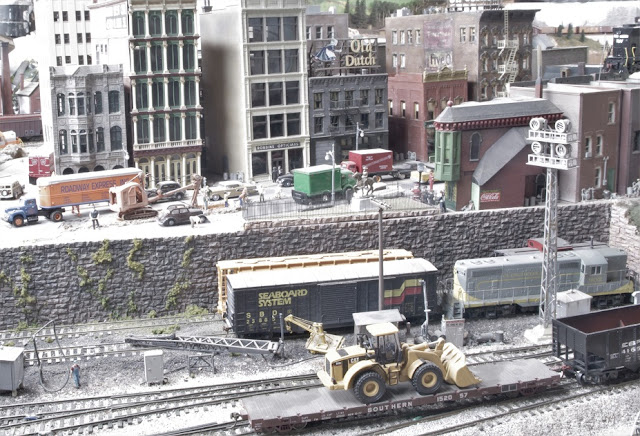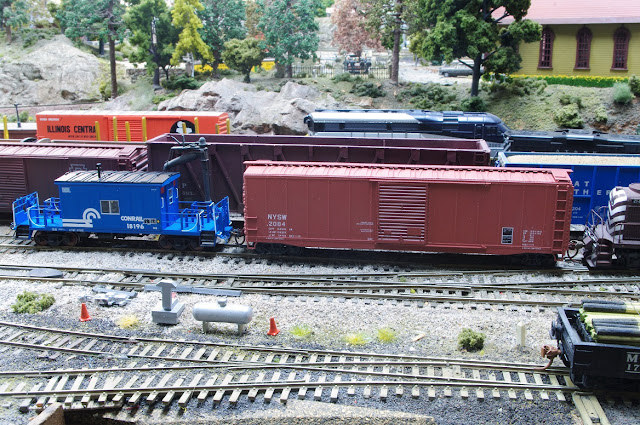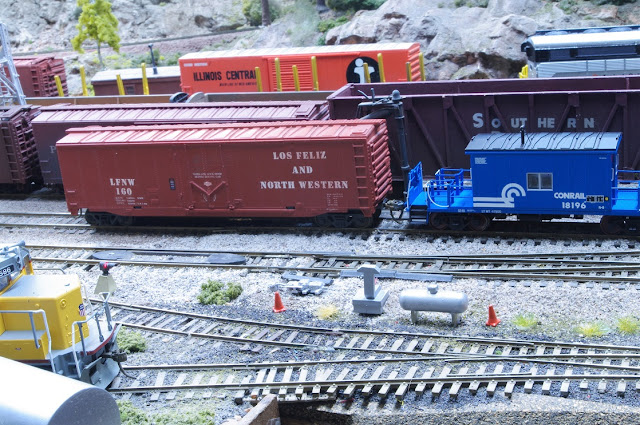A photo of a different BNSF car that I shot on Cajon shows that these cars stay fairly clean for whatever reason. The lettering on the model looks pretty good.
VCY 172217 is a bigger problem. Golden West Service was a Southern Pacific strategy dating from the late 1980s to finance rebuilt cars after the failure of the Santa Fe merger. VCY was the Ventura County Railway, which got ex-SP cars as part of a complicated financial arrangement. Others went to the Galveston Wharves Railroad. LBF or whoever it was did an OK job with the paint, although the darker blue the cars were delivered in has faded badly. In addition, the cars that actually went to the VCY weren't like these, they had a single plug door. Also, by about 2010, these cars were returned by the lessor to UP and relettered for SSW and SP, by now just UP reporting marks. So while these cars are still pretty common, this is what they look like now: Heavily faded and tagged, with the conspicuity stripes and a patch for SP-UP reporting marks and number. As far as I can tell, nobody makes decals for patching and renumbering Golden West Service cars, an important unfilled need for modelers who like to model what they railfan. I did lighten the blue as much as I could by airbrushing a mixture of white and flat finish onto the car. I'll probably at least tag it, and if I can find an easy way to renumber it and patch it, I will.Sunday, March 24, 2019
New From The Purgatory Box
Thursday, March 21, 2019
Lighting Effects
Here's a night view of two modules connected together with Just Plug LEDs in the buildings, as well as Kato N rail equipment equipped with DCC decoders in the locos and lighting kits in the coaches:
I get the impression from YouTube videos that modelers are finding advantages to the Just Plug system, with or without NCE Illuminators. Ordinary 12 volt incandescent bulbs have been available for model lighting for many decades, but the problems included short life of the bulbs, the heat of the bulbs, messy and non-standard wiring arrangements, the need to solder wiring together, often the need to go under the layout to make connections, and so forth. The combination of stick-on LEDs in a variety of sizes and colors, the hub-and-plug architecture, and the standardized components that can potentially be mounted in more accessible positions, are all big advantages.I used orange LEDs to light the interior of my tunnel, which was inspired by the West 45th St tunnel on Amtrak's Manhattan Empire Connection:
Here's my model: DCC increases the potential for lighting effects in any scale. In HO, some manufacturers offer a lot of flexibility in what lights can be lit on a locomotive. Kato and Walthers, at least, have HO lighting kits for passenger cars. However, so far, nobody has offered the lights that appear near the doors on modern passenger equipment. This would be a big plus!Sunday, March 17, 2019
PCCM 59L Part 4
City Coal and the West Zenith team track are served by the same turn that served Woollett earlier in this session. Today's work is being done by Norfolk and Western Alcos. Here's the interchange run arriving in Zenith Yard:
The first order of business is to run around the Southern flat with the front-end loader to get it placed for delivery at the West Zenith team track: Then it heads up the hill on Main 2: Here's the delivery to West Zenith Team Track: Then the turn runs up to the mainline switch and shoves back to the spur leading to Zenith Knitting Mills and City Coal: And here's a view of City Coal with the car at the spot: At least for my layout, when assigning cars, it's probably the best rule of thumb to assume that any industry has only one spot.Saturday, March 16, 2019
PCCM 59L Part 3
John also sent me PRR X29 9553 carrying carpet to City of Industry, CA. Again, since that's not on my layout, I'm not sure how to route it, and for now, since I've posted a list of industries on my layout, I'm going to stick with on-layout destinations, at least until I get a little more sophisticated with this thing. So PRR 9553 will also be routed to the Jaques team track and be interchanged via Reiden Lake. As we've discussed, Reiden Lake is where people cross over into the alternate universe on the TV show Fringe. I really need to have Massive Dynamic as an industry on my layout, come to think of it.
So here is the WP local bringing in the interchange from Reiden Lake:
The local pulls forward past the interchange with the alternate universe onto the main line at 14th Street in Bay City:
Then it shoves back on the main to Jaques:
And finally seesaws back to the Sunkist runner, part of which serves as the Jaques team track when needed:Friday, March 15, 2019
LF&NW Industry List By Region
Urban Area (Interchange at Zenith or West Egg as indicated)Zenith (Interchange at Zenith)
Cargill Grain -- outbound grain in covered hoppers or grain boxcars
Edison Electric Co -– inbound coal
Zenith Water District – Inbound coal, inbound chlorine in hazmat tank cars
Pillsbury Flour – inbound grain outbound flour, both in covered hoppers or clean lading boxccars
Team Track- – inbound lumber, rebar, pipeManhattan Transfer (Interchange via car float at West Egg)
Railway express – box express, express reefers, passenger baggage
US Post Office - inbound and outbound storage mail and packages in mail storage baggage-express cars
Forley Lithography -- inbound paper in 40 foot clean lading boxcarsWest Egg (Interchange via car float at West Egg)
Manufacturing – inbound food products in RBL cars and food tank cars
Crosby Coal – inbound coal
Valley Lumber – inbound lumber
South Shore Cement -- inbound cementAppalachian Region (CSX, NS, VGN, C&O, N&W, etc, interchange at Zenith)
East Zenith
Fertilizer -- inbound phosphate outbound bagged fertilizer
Rhubarb warehouse -- inbound fruit & vegetables in 40-foot reefers
Railway express – box express, express reefers, passenger baggageOak Hill
New River Mine – outbound coalNew England/Upstate New York/New Jersey (Interchange at Zenith)
West Zenith (Interchange at Zenith)
Zenith Knitting Mills - outbound textiles
City Coal – inbound coal, lumber
Team Track – inbound boxcars, flats, gons with lumber, rebar, etcWoollett
Jacobs Coal -- inbound Coal Fuel Oil
American Tool & Die -- outbound machine tools
Shoe Company -- inbound coal and hides, outbound shoes
Team Track – inbound lumber, steel, rebarCalifornia (Interchange at Reiden Lake)
Bay City
Edison Electric Co – inbound transformers, oil in box and tank cars
Pulpwood Spur - outbound pulpwoodJaques
Lemon Association -- outbound citrus
feed – inbound grain
elevator – outbound grain
Team Track – inbound lumber, outbound wine in RBL carsLoma Linda
Lumber company – outbound wood chips, cut lumber, logsMalabar
Huger Davidson Sale – Inbound ice reefers
Team Track – inbound miscellaneous freight, max 50 foot cars
Grain elevator – outbound grain, 36 and 40 foot boxcarsPaper Box –
inbound pulpwood, coal, wood chips; outbound paper, alcohol in tank cars
(Paper Box masquerades as a sugar beet processor as needed and ships outbound sugar)Rocky Mountain Region (Interchange at Reiden Lake)
Terrible
Terrible mill – outbound concentratesCantil
Cantil spur – outbound soda ash in covered hoppers
Tuesday, March 12, 2019
Explaining My Layout For Virtual Ops
You brought up a couple geographical dilemmas your layout faced during PCCM 59. Not having a totally clear conception of how you have your layout divided obviously contributed to the car routing issues.So I worked on updating the track plan to show regions of the country and locations, as well as an updated list of industries that may be of some help. I would point out that as far as I'm aware, our group is not closed, and others who may wish to participate in various ways are certainly welcome to join and start. You certainly don't have to have the sort of layout Tony Koester would approve of to do so, as my example ought to show.To remedy these car routings can you provide a map or list of the regions of the country you have included on your layout, the industries in these specific areas and any off layout interchanges via other RRs in these areas. Once we have that and a better understanding of your layout we can come up with better car routings and interchanges that will not be troublesome going forward.
Here is the track plan in the main layout room, with some color coding added to show geographical regions:
The colors are blue for New England (or upstate New York/northern New Jersey), orange for Rocky Mountains/Great Basin Desert, and yellow for California. Gray represents urban area, which extends across the aisle from Zenith to Manhattan Transfer. I recently added an extension to an adjoining storage room, reached through a hole in the wall near Reiden Lake on the main plan: Malabar is also in California, the idea is somewhat similar to branches in the Central Valley served by the Santa Fe, Southern Pacific, and Western Pacific. (You can click on that image to get a more readable plan.) An extension from Malabar reaches a micro layout now mounted on a connecting shelf, designed by Scottish modeler Jack Trollope, and originally named Box Street by him, now renamed Paper Box to represent a paper mill. Conceptually, this is still on the West Coast. I had a work assignment at such a mill in Bellingham, WA, which is something like what I have in mind. Jack's original plan is below:I should point out that Anthracite on the big plan is entirely HOn3, so standard HO equipment can't be routed there. Additional HOn3 trackage is under construction in the area where the Bay City name appears on the left hand peninsula.
John R is particularly concerned with setting up interchanges in a logical way. So here is how I see it: interchange with railroads west of the Mississippi and locations there will take place in Reiden Lake, which is actually a fictional location on the Fringe TV series where people cross over to the alternate universe. Zenith, as I explained in a previous post, is a fictional city created by the novelist Sinclair Lewis located, by his account, between Pittsburgh and Detroit. That's probably good enough for our use, although I had a work assignment in Rochester, NY, and sometimes think of it in locating structures and details. Interchange with railroads and locations east of the Mississippi should take place there.
West Egg is a town on Long Island, probably comparable to Great Neck or Oyster Bay, in Fitzgerald's The Great Gatsby. On the LF&NW, it has a car float connection to railroads serving New York Harbor, and interchange with the LV, PRR, NYC, Erie, Lackawanna, Jersey Central, Long Island, New Haven, and so forth can also take place via car float there. Manhattan Transfer can loosely be thought of as corresponding to Harrison, NJ, with Hoboken thrown in, but only very loosely.
I'll post an updated list of industries and shipments at each location on my layout in my next post.
Sunday, March 10, 2019
PCCM 59L Part 2
As we get more experience with these virtual moves, I'm realizing that the locations where other layouts interchange with the LF&NW are problematic. If the NYC sends cars to Zenith, since Zenith is definitely in the eastern half of the US (the city was named by the novelist Sinclair Lewis, who actually placed it somewhere between Pittsburgh and Detroit), it wouldn't be very logical to send cars all the way to California. On the other hand, the Ralston Creek Railroad in the Denver area might much more logically interchange in the western US with a western railroad. So I'm still trying to noggin this one out, and other guys may have ideas here, too.
So here are the California cars headed east. The Masonite car is seen on the Northwestern Pacific headed to the LF&NW, which will send it on to the NYC:
The WP Bulk Sugar car is being picked up at the American Sugar Refining Company plant in Betteravia: Now we come to the problem of the California interchange at Bay City. As you can see from the Italian boxcar to the left of the SP switcher, interchange here takes place with a number of other railroads. Maybe I need to rename this point Reiden Lake. I still have to do more thinking on how I'm going to interchange with different conceptual layouts in different areas, considering my own layout does conceptual changes in region all on its own!Saturday, March 9, 2019
PCCM 59L Part 1
The other layouts participating in this series are Neal M's Atlantic Pacific RR, PC Ralph's Kings Port Division, John R's New York Central Train Layout, and Brian's Ralston Creek RR.
The car movement form devised by John R has the following coming from my layout, the Los Feliz and North Western, to the Ralston Creek Railroad in the Denver area, and the New York Central Train Layout in Empire City. Here they are:
- A WP 40’ Bulk Sugar car will go from American Sugar and Refining in Bettaravia, CA to Jolly Rancher candies in Wheat Ridge, CO on the Ralston Creek.
- A GN 40’ dbl door box 59 American Tool & Die in Woollett to Gates Rubber on the Ralston Creek with replacement tool castings.
- LF&NW RBL car 160 will move from Zenith Knitting Mills in West Zenith to Moore & CO Exporters Outer Wear on the New York Central.
- D&H 40’ box 19123 will move from American Tool & Die in Woollett to Reliable Machine Machine castings on the Ralston Creek.
- A Masonite All door box car will move from the Masonite plant in Ukiah, CA on the Northwestern Pacific via the LF&NW to Neal’s Lumber on the New York Central.
This installment will cover the cars coming from Zenith Knitting Mills and American Tool and Die, which are both covered by a local turn out of Zenith. The makeup of today's train will variously make Big Mike Bednar cringe and smile if he's watching from a spot overlooking Zenith Yard. This is clearly early Conrail. The power is a Penn Central GP7 and a Lehigh Valley RS-2, with a Conrail cabin. But it's taking a NYS&W box up to to Woollett:
The first stop is Zenith Knitting Mills, where the local picks up LF&NW 160: The crew is going to save time and just tack the car behind the cabin. Here they're pulling the D&H and GN cars from American Tool and Die: And, after they leave the NYS&W car in Woollett, they're going to just pull and shove everything back to Zenith in the same order they picked it up: <


























































